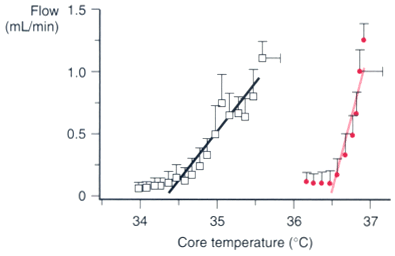 |
 |
Figure 40-6
Finger blood flow without (open
squares) and with (filled circles) desflurane
administration. Values were computed relative to the thresholds (finger flow = 1.0
mL/min) in each subject. Flows of exactly 1.0 mL/min are not shown because flows
in each individual were averaged over 0.1°C or 0.05°C increments; each data
point thus includes both higher and lower flows. The horizontal standard deviation
bars indicate variability in the thresholds among the volunteers; although errors
bars are shown only at a flow near 1.0 mL/min, the same temperature variability applies
to each data point. The slopes of the flowversus-core temperature relationships
(1.0 to approximately 0.15 mL/min) were determined by linear regression. These slopes
defined the gain of vasoconstriction with and without desflurane anesthesia. Gain
was reduced by a factor of 3, from 2.4 to 0.8 mL/min/°C (P
< .01). (Redrawn from Kurz A, Xiong J, Sessler DI, et al: Desflurane
reduces the gain of thermoregulatory arteriovenous shunt vasoconstriction in humans.
Anesthesiology 83:1212–1219, 1995.)

 |
